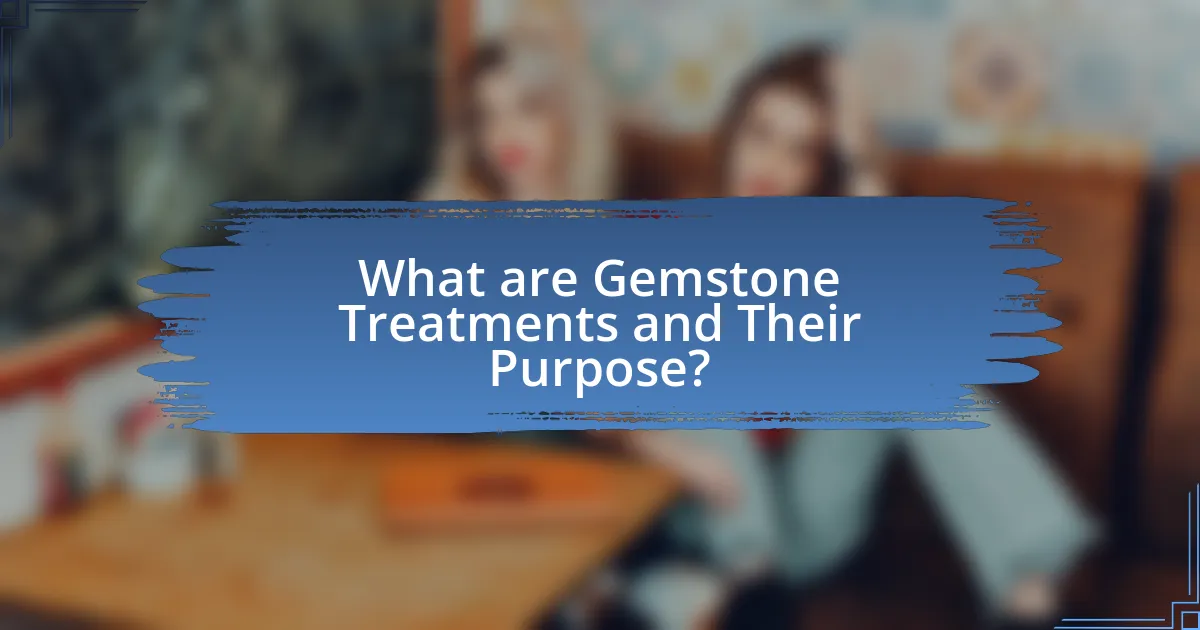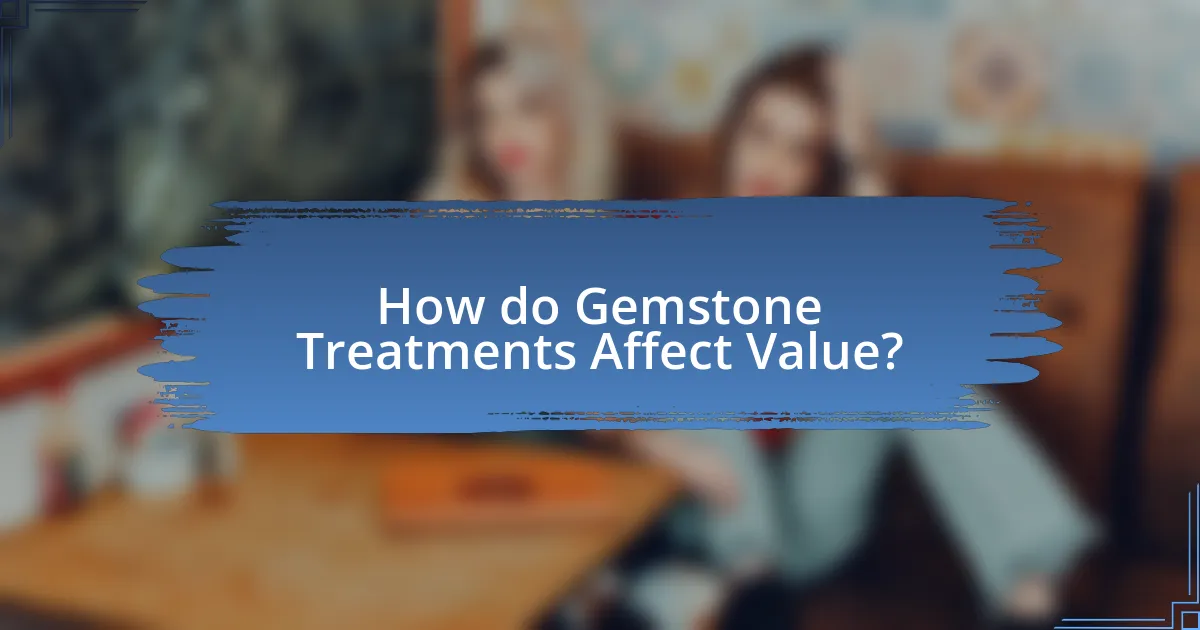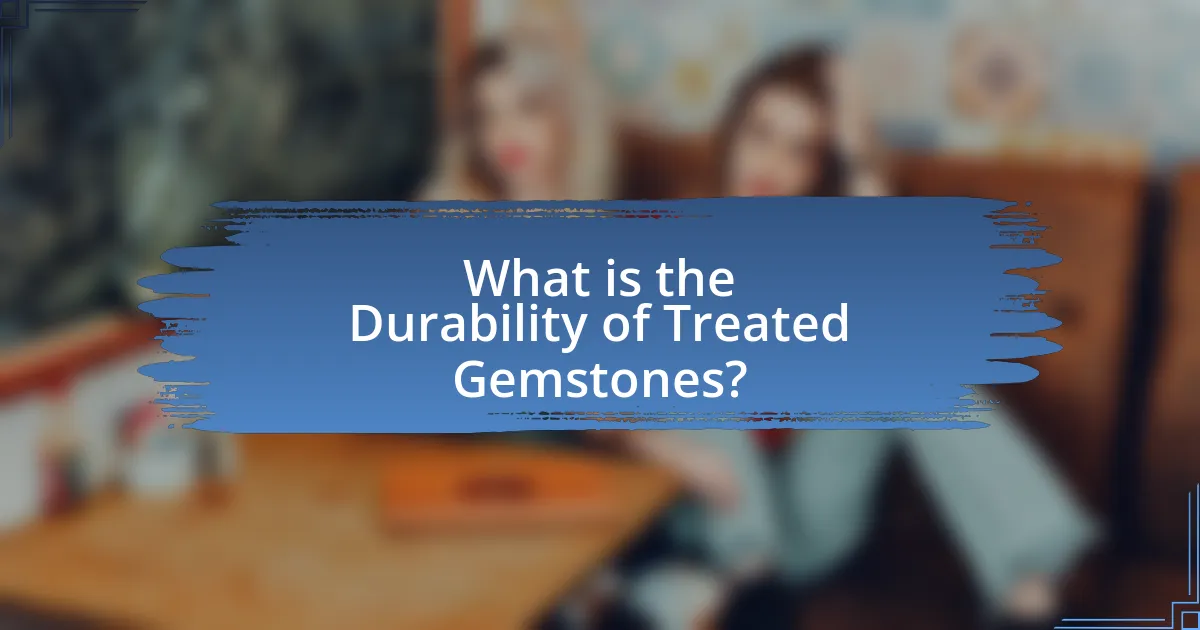Gemstone treatments encompass various processes applied to enhance the appearance, durability, and marketability of gemstones. Common methods include heat treatment, dyeing, and oiling, which improve color and clarity, thereby influencing the gemstone’s value. The article examines how these treatments affect the aesthetic appeal and pricing of gemstones, highlighting consumer perceptions of treated versus untreated stones. Additionally, it discusses the durability implications of treatments, the risks associated with them, and best practices for purchasing treated gemstones, emphasizing the importance of transparency and proper care in maintaining their value over time.

What are Gemstone Treatments and Their Purpose?
Gemstone treatments refer to various processes applied to gemstones to enhance their appearance, durability, or marketability. These treatments can include methods such as heating, dyeing, and oiling, which aim to improve color, clarity, and overall visual appeal. For instance, heat treatment is commonly used on sapphires and rubies to intensify their color, while oiling is often applied to emeralds to fill surface fractures and enhance clarity. The purpose of these treatments is to increase the gemstone’s aesthetic value and, consequently, its market price, as untreated stones are typically more valuable due to their rarity.
How do gemstone treatments enhance the appearance of stones?
Gemstone treatments enhance the appearance of stones by improving their color, clarity, and overall visual appeal. Techniques such as heat treatment can intensify color and remove inclusions, while processes like oiling can fill surface cracks, making the stone appear more flawless. For instance, heat-treated sapphires can exhibit a deeper blue hue, significantly increasing their market value and desirability. Additionally, treatments like dyeing can alter the color of stones such as jade, creating vibrant shades that attract buyers. These enhancements not only elevate the aesthetic qualities of gemstones but also influence their perceived value in the market.
What specific treatments are commonly used to improve color and clarity?
Common treatments used to improve color and clarity in gemstones include heat treatment, irradiation, and oiling. Heat treatment enhances color and clarity by altering the internal structure of the gemstone, as seen in sapphires and rubies, where temperatures can exceed 1,600 degrees Celsius. Irradiation involves exposing gemstones to radiation to change their color, commonly used for diamonds and topaz. Oiling, particularly in emeralds, fills surface-reaching fractures with oils or resins, improving clarity and appearance. These treatments are widely recognized in the gem industry and can significantly affect a gemstone’s market value and durability.
How do these treatments affect the overall aesthetic appeal of gemstones?
Gemstone treatments significantly enhance the overall aesthetic appeal of gemstones by improving their color, clarity, and brilliance. For instance, treatments such as heat treatment can intensify the color of sapphires and rubies, making them more visually striking. Additionally, clarity enhancements, like laser drilling or filling, can reduce the visibility of inclusions, resulting in a cleaner appearance that is more desirable to consumers. According to a study published in the Journal of Gemmology, treated gemstones often exhibit a higher market value due to their enhanced visual characteristics, demonstrating that treatments directly influence both aesthetic appeal and economic worth.
Why are gemstone treatments important in the jewelry industry?
Gemstone treatments are important in the jewelry industry because they enhance the appearance, durability, and overall value of gemstones. Treatments such as heating, dyeing, and oiling can improve color, clarity, and stability, making stones more appealing to consumers. For instance, heat treatment is commonly used on sapphires and rubies to intensify their color, which can significantly increase their market value. According to a report by the Gemological Institute of America, treated gemstones can sell for up to 50% more than untreated ones, demonstrating the financial impact of these enhancements.
What role do treatments play in the pricing of gemstones?
Treatments significantly influence the pricing of gemstones by altering their appearance and perceived quality. For instance, untreated gemstones typically command higher prices due to their natural state, while treated stones, such as those enhanced through heat or dyeing, often sell for less because treatments can affect durability and authenticity. According to the Gemological Institute of America, untreated sapphires can be valued at up to three times more than their treated counterparts, illustrating the direct impact of treatments on market value.
How do consumers perceive treated versus untreated gemstones?
Consumers generally perceive untreated gemstones as more valuable and authentic compared to treated gemstones. This perception stems from the belief that untreated stones maintain their natural beauty and integrity, which is often associated with higher quality. According to a survey conducted by the Gemological Institute of America, 70% of consumers indicated a preference for untreated gemstones, citing reasons such as rarity and the absence of artificial enhancements. Additionally, untreated gemstones are often viewed as better investments, as their value tends to appreciate over time, while treated gemstones may depreciate due to perceived lower quality.

How do Gemstone Treatments Affect Value?
Gemstone treatments significantly affect their value by altering their appearance and durability. Treatments such as heat treatment, dyeing, and clarity enhancement can enhance the color and clarity of gemstones, making them more appealing to consumers. For instance, heat-treated sapphires can exhibit a deeper blue hue, which increases their market value compared to untreated stones. However, the presence of treatments can also lead to a decrease in value if buyers perceive them as less authentic or if the treatments are not disclosed. According to the Gemological Institute of America, untreated gemstones generally command higher prices due to their rarity and natural state, emphasizing the importance of transparency in the treatment process.
What factors influence the value of treated gemstones?
The value of treated gemstones is influenced by several key factors, including the type of treatment applied, the quality of the original gemstone, market demand, and the reputation of the treatment process. The type of treatment, such as heat treatment or dyeing, can enhance color and clarity, significantly impacting value; for example, heat-treated sapphires can be worth significantly more than untreated ones. The quality of the original gemstone, including its size, clarity, and color, also plays a crucial role, as higher-quality stones generally retain more value even after treatment. Market demand fluctuates based on trends and consumer preferences, which can elevate or diminish the perceived value of treated gemstones. Lastly, the reputation of the treatment process affects buyer confidence; treatments that are well-regarded and disclosed tend to maintain higher values compared to those that are undisclosed or viewed negatively.
How does the type of treatment impact a gemstone’s market value?
The type of treatment significantly impacts a gemstone’s market value by altering its perceived quality and rarity. For instance, untreated gemstones typically command higher prices due to their natural state, which is often associated with greater authenticity and desirability. In contrast, treated gemstones, such as those that have undergone heat treatment or dyeing, may have reduced market value because these processes can enhance color or clarity but also indicate a lack of natural characteristics. According to the Gemological Institute of America, untreated stones can be valued up to 50% more than their treated counterparts, reflecting the market’s preference for natural gemstones.
What are the long-term effects of treatments on gemstone valuation?
Long-term treatments on gemstones can significantly decrease their valuation due to perceived enhancements that may not be permanent. For instance, treatments like dyeing or fracture filling can alter a gemstone’s appearance, but over time, these enhancements may fade or become less effective, leading to a decline in market value. Historical data shows that untreated gemstones consistently command higher prices compared to treated ones; for example, untreated sapphires can sell for up to three times more than treated sapphires. Additionally, the Gemological Institute of America (GIA) emphasizes that transparency about treatments is crucial, as undisclosed treatments can lead to buyer distrust and further depreciation in value.
Why do some treatments increase value while others decrease it?
Some treatments increase the value of gemstones by enhancing their appearance or durability, while others decrease it due to potential damage or perceived artificiality. For instance, treatments like high-temperature annealing can improve the color and clarity of sapphires, making them more desirable and valuable. Conversely, treatments such as dyeing or fracture filling may lead to a decrease in value because they can compromise the integrity of the gemstone and are often viewed as less authentic by buyers. The Gemological Institute of America (GIA) states that untreated gemstones generally command higher prices due to their natural state, reinforcing the idea that the type of treatment significantly influences market value.
What are the most valuable treatments in the gemstone market?
The most valuable treatments in the gemstone market include heat treatment, oiling, and laser drilling. Heat treatment enhances the color and clarity of gemstones like sapphires and rubies, significantly increasing their market value; for instance, untreated sapphires can be worth up to five times more than heat-treated ones. Oiling, commonly applied to emeralds, improves clarity and is widely accepted in the market, with treated emeralds often fetching higher prices than untreated stones. Laser drilling is used to remove inclusions from diamonds, enhancing their appearance and value, as diamonds with fewer inclusions are more sought after. These treatments are recognized for their ability to improve the aesthetic qualities of gemstones, thereby impacting their overall market value.
How do industry standards affect the valuation of treated gemstones?
Industry standards significantly influence the valuation of treated gemstones by establishing criteria for quality, treatment disclosure, and market acceptance. These standards, set by organizations such as the Gemological Institute of America (GIA) and the International Gemological Institute (IGI), dictate how treatments are classified and reported, which directly impacts consumer trust and market demand. For instance, untreated gemstones typically command higher prices due to their perceived rarity and natural origin, while treated stones may be valued lower unless the treatment is well-documented and accepted within the industry. The GIA’s grading system, which includes treatment identification, provides a framework that helps buyers assess the value of treated gemstones accurately, ensuring transparency and consistency in the market.

What is the Durability of Treated Gemstones?
Treated gemstones generally exhibit varying levels of durability depending on the type of treatment applied. For instance, heat treatment enhances the color and clarity of gemstones like sapphires and rubies, making them more durable by improving their resistance to wear and tear. However, some treatments, such as dyeing or fracture filling, can compromise durability, making these gemstones more susceptible to damage from environmental factors or physical impact. Studies indicate that untreated gemstones typically maintain higher durability over time compared to those that have undergone extensive treatments, as the integrity of the stone remains intact.
How do treatments impact the physical durability of gemstones?
Treatments can significantly enhance or compromise the physical durability of gemstones. For instance, heat treatment can improve the color and clarity of sapphires and rubies, making them more visually appealing and potentially more durable by reducing internal stress. Conversely, some treatments, such as fracture filling with resins, can weaken a gemstone’s structure, making it more susceptible to damage. Research indicates that untreated gemstones generally maintain higher durability ratings compared to those that have undergone extensive treatments, as evidenced by the Mohs hardness scale, which measures scratch resistance. Therefore, while treatments can enhance aesthetic qualities, they may also introduce vulnerabilities that affect long-term durability.
What are the risks associated with various gemstone treatments?
The risks associated with various gemstone treatments include potential damage to the stone, alteration of its natural properties, and misrepresentation of value. For instance, heat treatment can enhance color but may also weaken the stone’s structure, making it more susceptible to breakage. Similarly, treatments like dyeing can lead to color fading over time, affecting the gemstone’s durability and aesthetic appeal. Additionally, some treatments may not be disclosed, leading to consumer deception regarding the true value of the gemstone. According to the Gemological Institute of America, untreated gemstones generally hold higher value than treated ones, emphasizing the importance of transparency in treatment disclosures.
How can consumers assess the durability of treated gemstones?
Consumers can assess the durability of treated gemstones by examining their treatment history, understanding the specific treatments applied, and evaluating the gemstone’s hardness and stability. Treatments such as heat treatment or oiling can enhance appearance but may affect durability; for instance, heat-treated sapphires are generally stable, while those treated with oils may require more care. Additionally, consumers can refer to standardized hardness scales, like the Mohs scale, which rates gemstones based on their scratch resistance, providing a clear indication of durability. For example, diamonds score a 10 on the Mohs scale, indicating exceptional durability, while softer stones like opals score a 5.5 to 6.5, suggesting they are more prone to damage.
What maintenance practices are recommended for treated gemstones?
Treated gemstones require specific maintenance practices to preserve their appearance and integrity. Regular cleaning with a soft cloth and mild soap is recommended to remove dirt and oils without damaging the treatment. Additionally, avoiding exposure to harsh chemicals, extreme temperatures, and prolonged sunlight helps maintain the gemstone’s color and clarity. It is also advisable to store treated gemstones separately in a soft pouch or lined box to prevent scratches and damage from other jewelry. These practices are essential as certain treatments, like dyeing or fracture filling, can be sensitive to environmental factors, which may affect the gemstone’s durability and value over time.
How does proper care affect the longevity of treated gemstones?
Proper care significantly enhances the longevity of treated gemstones by preventing damage and maintaining their appearance. Regular cleaning, appropriate storage, and avoiding exposure to harsh chemicals or extreme temperatures help preserve the integrity of treatments such as dyeing, heating, or irradiation. For instance, untreated gemstones can last indefinitely, while treated ones may degrade faster without proper maintenance. Studies indicate that gemstones subjected to heat treatment can lose their color if exposed to high temperatures or chemicals, underscoring the importance of careful handling. Therefore, diligent care directly correlates with the durability and aesthetic quality of treated gemstones over time.
What common mistakes should be avoided to preserve treated gemstones?
To preserve treated gemstones, avoid exposing them to harsh chemicals, extreme temperatures, and prolonged sunlight. Harsh chemicals, such as bleach or ammonia, can damage the treatments applied to gemstones, leading to discoloration or deterioration. Extreme temperatures can cause thermal shock, which may crack or fracture the stones. Prolonged exposure to sunlight can fade the color of treated gemstones, particularly those that have undergone dyeing or irradiation processes. These practices are essential for maintaining the integrity and appearance of treated gemstones, ensuring their value and durability over time.
What are the best practices for purchasing treated gemstones?
The best practices for purchasing treated gemstones include verifying the treatment disclosure, obtaining a certification from a reputable gemological laboratory, and understanding the implications of the treatment on the gemstone’s value and durability. Verifying treatment disclosure ensures that the buyer is aware of any enhancements that may affect the gemstone’s appearance and longevity. Certification from a recognized laboratory, such as the Gemological Institute of America (GIA) or the American Gem Society (AGS), provides an unbiased assessment of the gemstone’s quality and treatment status. Understanding the implications of treatments, such as heat treatment or dyeing, is crucial as these can significantly influence the gemstone’s market value and durability over time.


